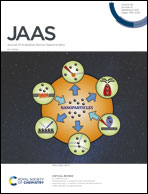Atomic spectrometry update – a review of advances in X-ray fluorescence spectrometry and its special applications
Abstract
That the boundaries of analysis using XRF spectrometry performed at SR sources continues to be pushed back is evidenced by the nanoscale spatial resolution with near single-atom sensitivity for the most efficiently detected elements in nanobeam applications and high speed 2D/3D imaging capabilities. The 4th generation SR facilities currently under development, such as the ESRF Extremely Brilliant Source (EBS), will be at the forefront of these advances. A clear trend is that SR-XRF spectrometry is increasingly applied with complementary X-ray spectroscopic/imaging techniques to combine spatially resolved elemental information with speciation and structural/morphological imaging. The wide range of applications of scanning (sub)microXRF spectrometry for elemental imaging published in the period covered by this review included biomedical, environmental, materials science and cultural heritage studies. Most applications involved XAS and XRD methods at hard X-ray micro- and nano-probe facilities. Full field microXRF spectrometry has made very promising advances with respect to the optics used. Coded apertures have potential for overcoming the low count rates that often restrict the full potential of laboratory-based full-field setups. The availability of commercial full-field detectors will increase the user community and thereby foster advancement in full field microXRF spectrometry. The TXRF spectrometry of ambient air is becoming more and more sophisticated and the advantages of this micro analytical tool over ICP-MS in terms of short sampling times with high particle size resolution are becoming ever more apparent. For example, the optimal sampling time for aerosols for TXRF analysis was well below 12 hours, whereas that for ICP-MS analysis was about 24 hours. High-quality grazing incidence XRF analysis in the laboratory has become more feasible with the development of prototype TXRF instrumentation and the availability of commercial XRD setups with energy dispersive detectors. Portable XRF spectrometry has undergone significant technological improvements in recent years and is now applied in a wide range of applications. This is reflected in a significant number of valuable review papers dealing with different aspects of the portable XRF technique. The growth in the use of macroXRF scanning systems in cultural heritage investigations has required development of new software and methodologies for efficient handling of the huge data files generated. In several contributions the possibilities of a new scanning station equipped with real time macroXRF spectrometry was demonstrated.

- This article is part of the themed collection: Atomic Spectrometry Updates


 Please wait while we load your content...
Please wait while we load your content...